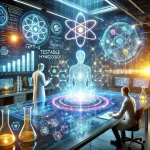
The Future of Bioinformatics in the Age of AI: Adaptation or Replacement?
September 12, 2023Will AI replace Bioinformatics Jobs
Introduction:
The field of bioinformatics is evolving, and artificial intelligence (AI) is impacting its evolution. Currently AI impact and influence in bioinformatics remain uncertain, but we cannot deny that AI is reshaping bioinformatics field. In this post, we will see how AI in bioinformatics is impacting bioinformatics, what the essential skills are that bioinformatics scientists should learn for effective integration of AI, and what difficulties are associated with AI integration workflows.
Will AI Replace Bioinformatics?
The integration of AI into bioinformatics has many views, and some speculate it will replace bioinformaticians, but the available data suggest a more nuanced perspective. A survey on willrobotstakemyjob.com indicates a modest 17% chance of automation for bioinformatics scientists. Moreover, a LinkedIn article paints an optimistic picture of bioinformatics, with AI tools continuing to proliferate within the field. While AI is changing research methodologies, the unique expertise and creativity of human bioinformaticians remain essential.
How Can Bioinformatics Scientists Prepare for the AI Era?
Bioinformatics scientists can proactively position themselves for success in the AI era by taking several strategic steps:
1. Stay Informed: Keeping up-to-date with the latest AI tools and technologies is crucial.
2. Skill Development: Gaining proficiency in AI and machine learning can be a valuable asset in the evolving landscape.
3. Collaboration: Partnering with AI experts can lead to the development of innovative tools and enhance overall efficiency.
4. Specialization: Focusing on areas less likely to be automated, such as data analysis, interpretation, and visualization, can enhance one’s value.
5. Embrace Change: Being adaptable and open to new ways of working is vital in the age of AI.
By adopting these strategies, bioinformatics scientists can continue to make meaningful contributions to their field amid the ongoing AI revolution.
Key Skills for Bioinformatics Scientists Collaborating with AI
To effectively collaborate with AI in bioinformatics, scientists should cultivate specific skills, including:
1. Educational Background: A strong foundation in biology, bioinformatics, or related fields is essential.
2. Programming Proficiency: Mastery of programming languages such as Python, R, Matlab, Perl, C/C++, and Java is valuable.
3. Statistical Expertise: Strong critical thinking, problem-solving, analytical reasoning, and advanced mathematical skills, along with statistical knowledge for data analysis, are necessary.
4. Biology Knowledge: A profound understanding of genomics, genetics, and database management is essential.
5. Data Mining and Machine Learning: Proficiency in data mining and machine learning techniques for analyzing extensive datasets is advantageous.
6. Effective Communication: Strong communication skills enable seamless collaboration within multidisciplinary teams comprising biologists, plant scientists, and computer research scientists.
Possessing these competencies empowers bioinformatics scientists to leverage AI effectively in their work.
Challenges in Integrating AI into Bioinformatics Workflows
The integration of AI into bioinformatics workflows presents several challenges, including:
1. Data Quality and Quantity: AI thrives on vast amounts of high-quality data, but bioinformatics data is often complex, diverse, and noisy, making AI model training a challenging task.
2. Algorithmic Uncertainty: The intricacy of AI algorithms and their opacity can hinder comprehension, particularly when incorrect predictions can have significant consequences.
3. Technical Expertise: Seamlessly incorporating AI demands expertise in both AI and bioinformatics, requiring distinct skill sets.
4. Ethical and Legal Complexities: The use of AI in bioinformatics raises ethical and legal considerations, including data privacy, ownership, and bias, which require careful consideration and resolution.
5. Workflow Integration: Infusing AI into existing bioinformatics workflows necessitates adjustments to processes and systems, which can be challenging in large organizations with complex workflows.
Addressing these challenges head-on equips bioinformatics scientists to adeptly integrate AI into their workflows, harnessing the advantages AI offers.
AI’s Role in Enhancing Accuracy in Bioinformatics Analysis
AI significantly improves accuracy in bioinformatics analysis through various avenues:
1. Gene Prediction and Variant Analysis: AI-driven algorithms, especially deep learning models, demonstrate exceptional accuracy in gene prediction and variant analysis, shedding light on the genetic basis of diseases.
2. Drug Analysis: AI expedites drug analysis by tapping into pertinent databases, such as BindingDB and DrugBank, to pinpoint potential drug targets and predict drug efficacy, expediting drug discovery.
3. Sequence Analysis: From sequence analysis to drug design, AI streamlines processes previously reliant on manual efforts, enhancing both accuracy and speed.
4. Explainable AI: The adoption of explainable AI methods enhances transparency and aids in comprehending AI algorithms, contributing to improved accuracy.
5. Clinical and Genomic Diagnostics: AI systems surpass conventional methods and secure FDA clearance for various clinical diagnostics, especially imaging-based diagnostics. AI aids in the identification of disease biomarkers and predictions concerning patient outcomes, heightening diagnostic precision.
Leveraging AI in these capacities empowers bioinformatics scientists to elevate the precision and efficiency of their analyses.
Current Applications of AI in Bioinformatics
AI already plays a significant role in various facets of bioinformatics, encompassing:
1. Protein Structure Prediction: AI conquers formidable bioinformatics challenges, such as protein structure prediction, homology search, multiple sequence alignment, and protein-protein interaction analysis.
2. Facilitating Gene Editing: Machine learning streamlines gene editing experiments.
3. Biological Sequence Matching: AI assumes a pivotal role in biological sequence matching, a fundamental bioinformatics application.
4. Biological System Modeling: AI aids in modeling complex biological systems, representing an advanced bioinformatics application.
5. Drug Design and Discovery: AI assumes a central role in designing and discovering pharmaceuticals.
6. Explainable AI: The burgeoning field of explainable AI promises greater transparency and interpretability, with applications in biomarker identification and the prediction of drug responses.
These applications underscore the multifaceted role AI plays in advancing bioinformatics research.
In summary, the synergy between AI and bioinformatics represents a period of collaboration and evolution, rather than replacement. Bioinformatics scientists have the capacity to adapt, cultivate new skills, and embrace AI to amplify the precision and efficiency of their work. While challenges exist, the current real-world applications of AI in bioinformatics

















